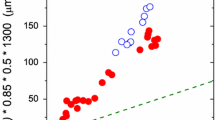Abstract
Seedlings of barley were grown either in continuous darkness or under a diurnal 12 h light/12 h dark cycle and the effects on NADPH-protochlorophyllide oxidoreductase were followed at two different levels. Firstly, the relative content of the mRNA encoding the NADPH-protochlorophyllide oxidoreductase was measured by dot-blot hybridization. Secondly, changes in the enzyme polypeptide were monitored either by the method of immunoblotting or by immunogold labelling of ultrathin sections of Lowicryl-embedded leaf tissue. Our results demonstrate that drastic diurnal changes in the level of mRNA sequences and the enzyme protein are unlikely to occur in plants which have been grown under natural light/dark conditions. In the dark, protein and mRNA accumulation occurs at an early developmental stage. These results are difficult to reconcile with the suggestion that the massive accumulation of mRNA and enzyme protein in dark-grown seedlings is primarily the consequence of an artificially extended darkperiod. In addition to the plastid-specific NADPH-protochlorophyllide oxidoreductase a closely related polypeptide has been detected outside the plastid in the surrounding cytoplasm (Dehseh et al. 1986b, Planta 169, 172–183). During the diurnal light/dark treatment of seedlings the concentrations of the two protein populations did not show any variation indicative of an exchange between the two protein populations across the plastid envelope.
Similar content being viewed by others
Abbreviations
- poly(A)+RNA:
-
polyadenylated RNA
References
Apel, K. (1981) The protochlorophyllide holochrome of barley (Hordeum vulgare L.). Phytochrome-induced decrease of translatable mRNA coding for the NADPH-protochlorophyllide oxidoreductase. Eur. J. Biochem. 120, 89–93
Apel, K., Kloppstech, K. (1978) The plastid membranes of barley (Hordeum vulgare). Light-induced appearance of mRNA coding for the apoprotein of the light-harvesting chlorophyll a/b protein. Eur. J. Biochem. 85, 581–588
Batschauer, A., Apel, K. (1984) An inverse control by phytochrome of the expression of two nuclear genes in barley (Hordeum vulgare L.). Eur. J. Biochem. 143, 593–597
Birnboim, H., Doly, J. (1979) A rapid alkaline extraction procedure for screening recombinant plasmid DNA. Nucleic Acids Res. 7, 1513–1523
Boardmann, N.K. (1966) Protochlorophyll, In: The chlorophylls, pp. 437–479, Vernon, L.P., Seely, G.R., eds. Academic Press, New York
Castelfranco, P.A., Beale, S.J. (1983) Chlorophyll biosynthesis: Recent advances and areas of current interest. Annu. Rev. Plant Physiol. 34, 241–278
Dehesh, K., Häuser, I., Apel, K, Kloppstech, K. (1983) The distribution of NADPH-protochlorophyllide oxidoreductase in relation to chlorophyll accumulation along the barley leaf gradient. Planta 158, 134–139
Dehesh, K., v. Cleve, B., Ryberg, M., Apel, K. (1986a) Light-induced changes in the distribution of the 36000-Mr polypeptide of the NADPH-protochlorophyllide oxidoreductase within different cellular compartments of barley (Hordeum vulgare L.). II. The localization of the polypeptide as revealed by the method of immunogold labelling in ultrathin sections of barley leaves. Planta 169, 172–183
Dehesh, K., Klaas, M., Häuser, I., Apel, K. (1986b) Light-induced changes in the distribution of the 36000-Mr polypeptide of the NADPH-protochlorophyllide oxidoreductase within different cellular compartments of barley (Hordeum vulgare L.). I. Localization by immunoblotting in isolated plastids and total leaf extracts. Planta 169, 162–171
Dehesh, K., Kreuz, K., Apel, K. (1986c) Chlorophyll synthesis in green leaves and isolated chloroplasts of barley (Hordeum vulgare L.). Physiol. Plant., in press
Griffiths, W.T. (1974) Source of reducing equivalents for the in vitro synthesis of chlorophyll from protochlorophyll. FEBS Lett. 46, 301–304
Griffiths, W.T. (1978) Reconstitution of chlorophyllide formation by isolated etioplast membranes. Biochem. J. 174, 681–692
Griffiths, W.T., Kay, A.S., Oliver, R.P. (1985) The presence of photoregulation of protochlorophyllide reductase in green tissues. Plant Mol. Biol. 4, 13–22
Harpster, M., Apel, K. (1985) The light-dependent regulation of gene expression during plastid development in higher plants. Physiol. Plant. 64, 147–152
Häuser, I., Dehesh, K., Apel, K. (1984) The proteolytic degradation in vitro of the NADPH-protochlorophyllide oxidoreductase of barley (Hordeum vulgare L.). Arch. Biochem. Biophys. 228, 577–586
Ikeuchi, M., Murakami, S. (1982) Behavior of the 36000-dalton protein in the internal membrane of squash etioplast during greening. Plant Cell Physiol. 23, 575–583
Ikeuchi, M., Murakami, S. (1984) Changes in the properties of protochlorophyllide reductase during early greening of etiolated squash cotyledons. In: Protochlorophyllide reduction and greening, pp. 31–42, Sironval, C., Brouers, M., eds. Martinus Nijhoff/Dr. W. Junk publishers, The Hague, Boston, Lancaster
Kay, S. A., Griffiths, W.T. (1983) Light-induced breakdown of NADPH-protochlorophyllide oxidoreductase in vitro. Plant Physiol. 72, 229–236
Laemmli, U.K. (1970) Cleavage of structural proteins during the assembly of the head of bacteriophage T4. Nature 227, 680–685
Mapleston, E.R., Griffiths, W.T. (1980) Light modulation of the activity of protochlorophyllide reductase. Biochem. J. 189, 125–133
Meyer, G., Bliedung, H., Kloppstech, K. (1983) NADPH-protochlorophyllide oxidoreductase: Reciprocal regulation in Mono- and Dicotyledonean plants. Plant Cell Rep. 2, 26–29
Santel, H.J., Apel, K. (1981) The protochlorophyllide holochrome of barley (Hordeum vulgare L.). The effect of light of the NADPH-protochlorophyllide oxidoreductase. Eur. J. Biochem. 120, 95–103
Towbin, M., Staehelin, T., Gordon, J. (1979) Electrophoretic transfer of proteins from polyacrylamide gels to nitrocellulose sheets; procedure and some applications. Proc. Natl. Acad. Sci. USA 76, 4350–4354
Author information
Authors and Affiliations
Rights and permissions
About this article
Cite this article
Häuser, I., Dehesh, K. & Apel, K. Light-induced changes in the amounts of the 36000-Mr polypeptide of NADPH-protochlorophyllide oxidoreductase and its mRNA in barley plants grown under a diurnal light/dark cycle. Planta 170, 453–460 (1987). https://doi.org/10.1007/BF00402979
Received:
Accepted:
Issue Date:
DOI: https://doi.org/10.1007/BF00402979




